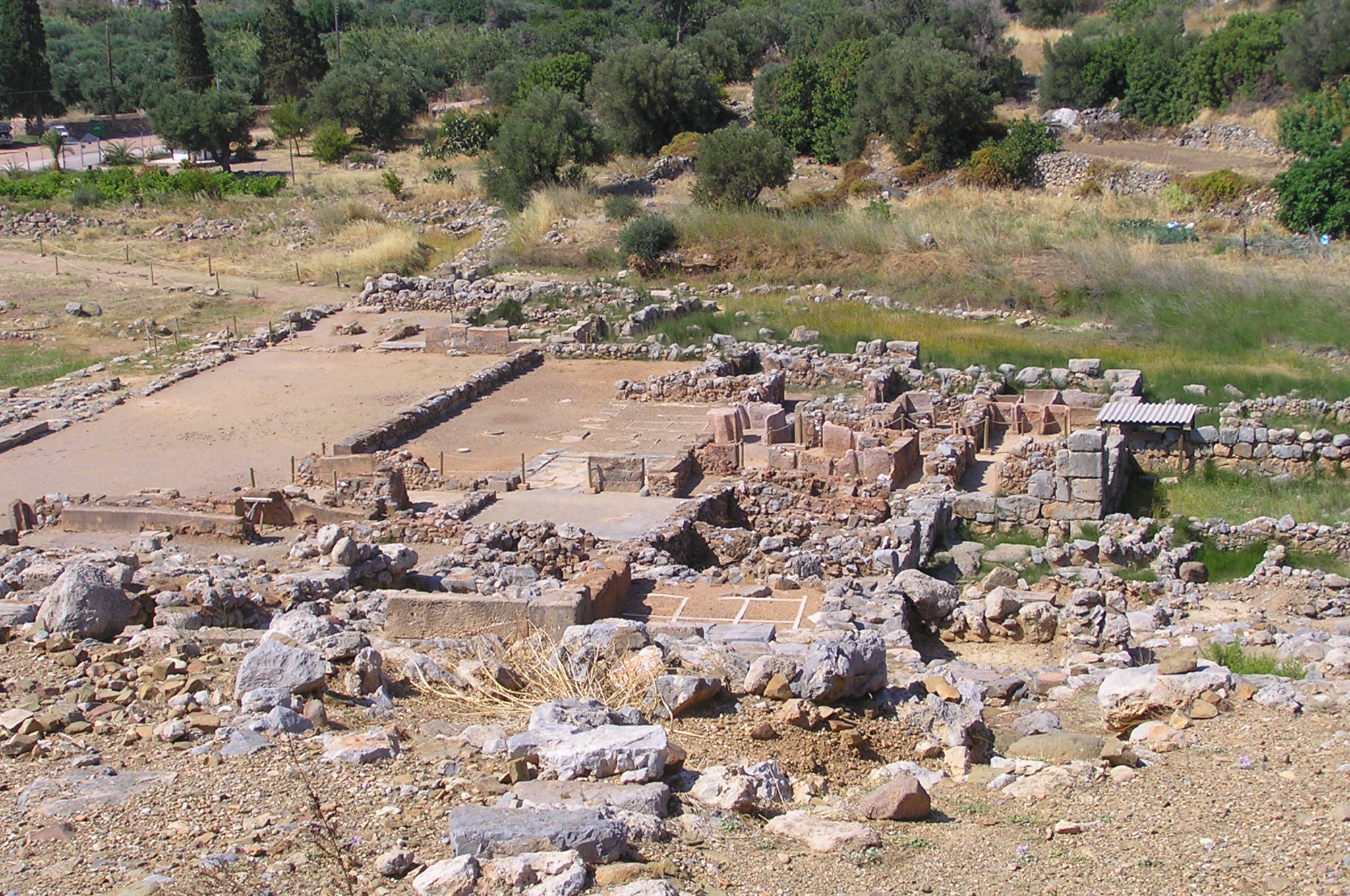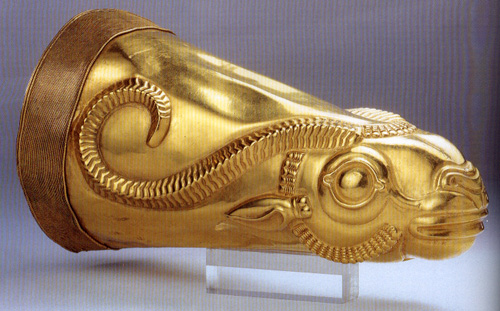|
Sklavokampos
Sklavokampos (also Sklavokambos) is the archaeological site of an ancient Minoan settlement in Crete, used during the Late Minoan period. Geography Sklavokampos is southwest of Tylissos, at the road that connects in with Anogeia, 22 kilometres from Heraklion. It is a valley near Gonies gorge. Archaeology The site was discovered while constructing a road to Anogeia and was first excavated in the 1930s. A multiple-story building was found at the site. Its main room yielded a clay ox head, a LMIB style jug and a stone rhyton. The building had at least 17 rooms. Finds from an upper story included 39 sealings, a cylindrical vessel, a stone hammer and a clay foot. Seal impressions from one the Sklavokampos sealings have been found in Zakros, Gournia and Hagia Triada. No frescoes or gypsum finishings, which are commonly found in Minoan palaces, were found at the Sklavokampos building. See also *List of ancient Greek cities A ''list'' is any set of items in a row. List or lists m ... [...More Info...] [...Related Items...] OR: [Wikipedia] [Google] [Baidu] |
Tylissos
Tylisos (also Pyrgos-Tylissos or Tylissos; el, Τύλισος; Linear B: ''Tu-li-so'') Palaeolexicon. is a town and a former municipality in the Heraklion regional unit, , . Since the 2011 local government reform it is part of the municipality , of which it is a municipal unit. The municipal ... [...More Info...] [...Related Items...] OR: [Wikipedia] [Google] [Baidu] |
Hagia Triada
Hagia Triada (also Ayia Triada, Agia Triada, Agia Trias, , "Holy Trinity") is the archaeological site of an ancient Minoan settlement. Hagia Triada is situated on the western end of a prominent coastal ridge, with Phaistos at the eastern end and the Mesara Plain below. Hagia Triada has yielded more Linear A tablets than any other Minoan site. Important finds include the Hagia Triada sarcophagus, and three carved stone vessels, known as the "Chieftain's Cup", the "Boxer Vase", and the Harvester Vase. After the destruction of the palace at Phaistos in around 1450 BC, it was not rebuilt and Hagia Triada and its harbour settlement of Kommos took over as the local capital for south-central Crete, continuing until the 13th century BC. Geography Hagia Triada is in south central Crete, 30–40 meters above sea level. It lies four kilometers west of Phaistos, which is situated at the western end of the Mesara Plain. The site was not a Minoan palace but an upscale town and possibly a ... [...More Info...] [...Related Items...] OR: [Wikipedia] [Google] [Baidu] |
Minoan Sites In Crete
The Minoan civilization was a Bronze Age Aegean civilization on the island of Crete and other Aegean Islands, whose earliest beginnings were from 3500BC, with the complex urban civilization beginning around 2000BC, and then declining from 1450BC until it ended around 1100BC, during the early Greek Dark Ages, part of a wider bronze age collapse around the Mediterranean. It represents the first advanced civilization in Europe, leaving behind a number of massive building complexes, sophisticated art, and writing systems. Its economy benefited from a network of trade around much of the Mediterranean. The civilization was rediscovered at the beginning of the 20th century through the work of British archaeologist Sir Arthur Evans. The name "Minoan" derives from the mythical King Minos and was coined by Evans, who identified the site at Knossos with the labyrinth of the Minotaur. The Minoan civilization has been described as the earliest of its kind in Europe, and historian Will Dur ... [...More Info...] [...Related Items...] OR: [Wikipedia] [Google] [Baidu] |
Heraklion (regional Unit)
Heraklion ( el, Περιφερειακή ενότητα Ηρακλείου) is one of the four regional units of Crete. The capital is the city of Heraklion. Geography The regional unit of Heraklion borders on the regional units of Rethymno to the west and Lasithi to the east. Farmlands are situated in the central and the northern parts, at the coast and in valleys. The mountains dominate the rest of the regional unit, notably the south. The main mountains are parts of Ida or Idi Mountains to the west and Asterousia in the south. The regional unit includes the island of Dia to the north. Except for the mountains which receive mild to cool winters unlike northern Greece, the warm to hot Mediterranean climate dominates the regional unit. Ancient history Within the Heraklion regional unit's boundaries are a number of significant Neolithic and Minoan settlements, most notably the ancient palace complexes of Knossos and Phaistos. While both archaeological sites evince Neolithi ... [...More Info...] [...Related Items...] OR: [Wikipedia] [Google] [Baidu] |
List Of Ancient Greek Cities
A ''list'' is any set of items in a row. List or lists may also refer to: People * List (surname) Organizations * List College, an undergraduate division of the Jewish Theological Seminary of America * SC Germania List, German rugby union club Other uses * Angle of list, the leaning to either port or starboard of a ship * List (information), an ordered collection of pieces of information ** List (abstract data type), a method to organize data in computer science * List on Sylt, previously called List, the northernmost village in Germany, on the island of Sylt * ''List'', an alternative term for ''roll'' in flight dynamics * To ''list'' a building, etc., in the UK it means to designate it a listed building that may not be altered without permission * Lists (jousting), the barriers used to designate the tournament area where medieval knights jousted * ''The Book of Lists'', an American series of books with unusual lists See also * The List (other) * Listing (di ... [...More Info...] [...Related Items...] OR: [Wikipedia] [Google] [Baidu] |
Gypsum
Gypsum is a soft sulfate mineral composed of calcium sulfate dihydrate, with the chemical formula . It is widely mined and is used as a fertilizer and as the main constituent in many forms of plaster, blackboard or sidewalk chalk, and drywall. Alabaster, a fine-grained white or lightly tinted variety of gypsum, has been used for sculpture by many cultures including Ancient Egypt, Mesopotamia, Ancient Rome, the Byzantine Empire, and the Nottingham alabasters of Medieval England. Gypsum also crystallizes as translucent crystals of selenite. It forms as an evaporite mineral and as a hydration product of anhydrite. The Mohs scale of mineral hardness defines gypsum as hardness value 2 based on scratch hardness comparison. Etymology and history The word ''gypsum'' is derived from the Greek word (), "plaster". Because the quarries of the Montmartre district of Paris have long furnished burnt gypsum (calcined gypsum) used for various purposes, this dehydrated gypsum became known ... [...More Info...] [...Related Items...] OR: [Wikipedia] [Google] [Baidu] |
Fresco
Fresco (plural ''frescos'' or ''frescoes'') is a technique of mural painting executed upon freshly laid ("wet") lime plaster. Water is used as the vehicle for the dry-powder pigment to merge with the plaster, and with the setting of the plaster, the painting becomes an integral part of the wall. The word ''fresco'' ( it, affresco) is derived from the Italian adjective ''fresco'' meaning "fresh", and may thus be contrasted with fresco-secco or secco mural painting techniques, which are applied to dried plaster, to supplement painting in fresco. The fresco technique has been employed since antiquity and is closely associated with Italian Renaissance painting. The word ''fresco'' is commonly and inaccurately used in English to refer to any wall painting regardless of the plaster technology or binding medium. This, in part, contributes to a misconception that the most geographically and temporally common wall painting technology was the painting into wet lime plaster. Even in appar ... [...More Info...] [...Related Items...] OR: [Wikipedia] [Google] [Baidu] |
Zakros
Zakros ( el, Ζάκρος; Linear B: zakoro) is a site on the eastern coast of the island of Crete, Greece, containing ruins from the Minoan civilization. The site is often known to archaeologists as Zakro or Kato Zakro. It is believed to have been one of the four main administrative centers of the Minoans, and its protected harbor and strategic location made it an important commercial hub for trade to the east. Flinders Petrie related Zakro with Tjeker of the Sea Peoples. The town was dominated by the Palace of Zakro, originally built around 1900 BC, rebuilt around 1600 BC, and destroyed around 1450 BC along with the other major centers of Minoan civilization. Extensive ruins of the palace remain, and are a popular tourist destination. Geography Zakros is sometimes divided into ''Epano Zakros'' (''Upper Zakros''), the portion higher up on the hillside, and ''Kato Zakros'' (''Lower Zakros''), the part near the sea. A ravine known as the "Ravine of the Dead" runs through both the ... [...More Info...] [...Related Items...] OR: [Wikipedia] [Google] [Baidu] |
Gournia
Gournia ( el, Γουρνιά) is the site of a Minoan palace complex on the island of Crete, Greece, excavated in the early 20th century by the American archaeologist, Harriet Boyd-Hawes. The original name for the site is unknown. The modern name comes from the abundant hollow vessels found all over the site. Gournia lies in the municipality of Ierapetra in the prefecture of Lasithi. Chronology The overarching term "Bronze Age" means something different depending on the culture and region of the world being studied. The Aegean Bronze Age is defined according to the place, which are mainland, Aegean islands, and Crete. These are referred to as Helladic, Cycladic, and Minoan respectively. Although Crete is an island in the Aegean, their culture is so distinctive from the ones considered to be Cycladic that it stands on its own. Archaeologists abbreviate the chronological periods using two prefixes. The first one always refers to the major Bronze Age period which are Early, Middl ... [...More Info...] [...Related Items...] OR: [Wikipedia] [Google] [Baidu] |
Minoan Civilization
The Minoan civilization was a Bronze Age Aegean civilization on the island of Crete and other Aegean Islands, whose earliest beginnings were from 3500BC, with the complex urban civilization beginning around 2000BC, and then declining from 1450BC until it ended around 1100BC, during the early Greek Dark Ages, part of a wider bronze age collapse around the Mediterranean. It represents the first advanced civilization in Europe, leaving behind a number of massive building complexes, Minoan art, sophisticated art, and writing systems. Its economy benefited from a network of trade around much of the Mediterranean. The civilization was rediscovered at the beginning of the 20th century through the work of British archaeologist Sir Arthur Evans. The name "Minoan" derives from the mythical Minos, King Minos and was coined by Evans, who identified the site at Knossos with the labyrinth of the Minotaur. The Minoan civilization has been described as the earliest of its kind in Europe, and his ... [...More Info...] [...Related Items...] OR: [Wikipedia] [Google] [Baidu] |
Rhyton
A rhyton (plural rhytons or, following the Greek plural, rhyta) is a roughly conical container from which fluids were intended to be drunk or to be poured in some ceremony such as libation, or merely at table. A rhyton is typically formed in the shape of an animal's head. Items were produced over large areas of ancient Eurasia, especially from Persia to the Balkans. Many have an opening at the bottom through which the liquid fell; others did not, and were merely used as drinking cups, with the characteristic that they could not usually be set down on a surface without spilling their contents. The English word ''rhyton'' originates in the ancient Greek word ' (''rhy̆tón ''or'' rhŭtón''). The conical rhyton form has been known in the Aegean region since the Bronze Age, or the 2nd millennium BC. However, it was by no means confined to that region. Similar in form to, and perhaps originating from, the drinking horn, it has been widespread over Eurasia since prehistoric tim ... [...More Info...] [...Related Items...] OR: [Wikipedia] [Google] [Baidu] |
.jpg)

.jpg)


